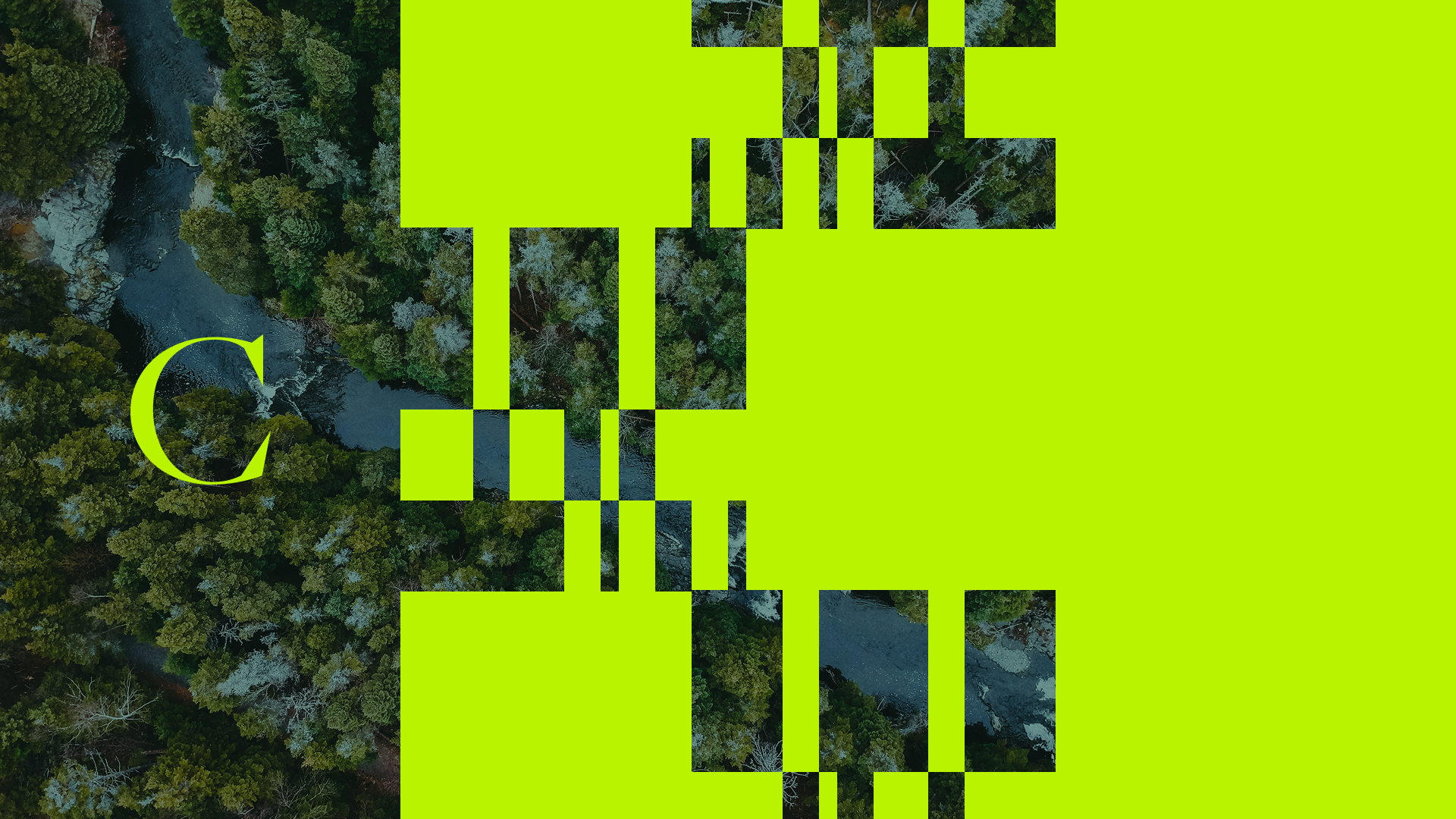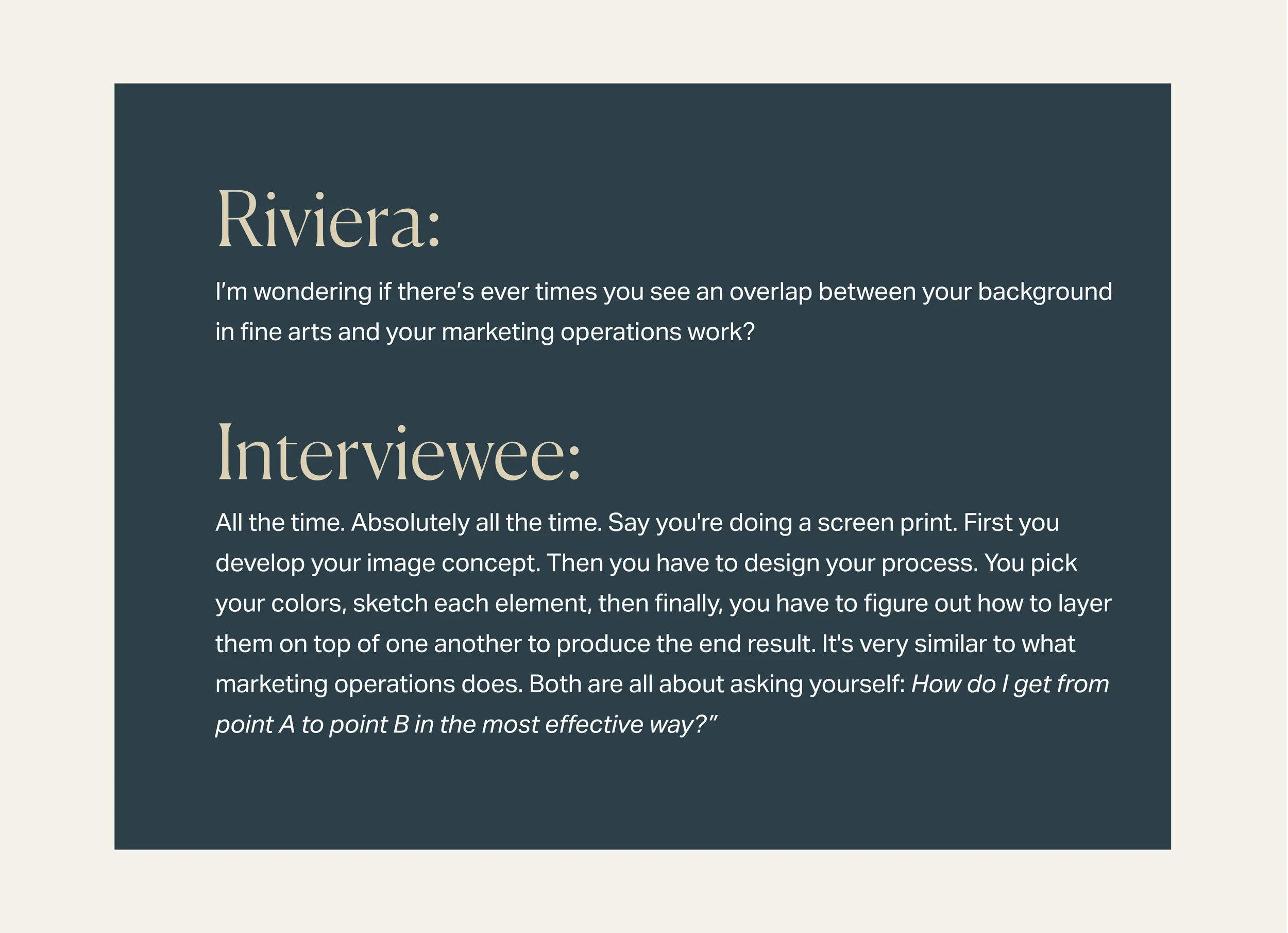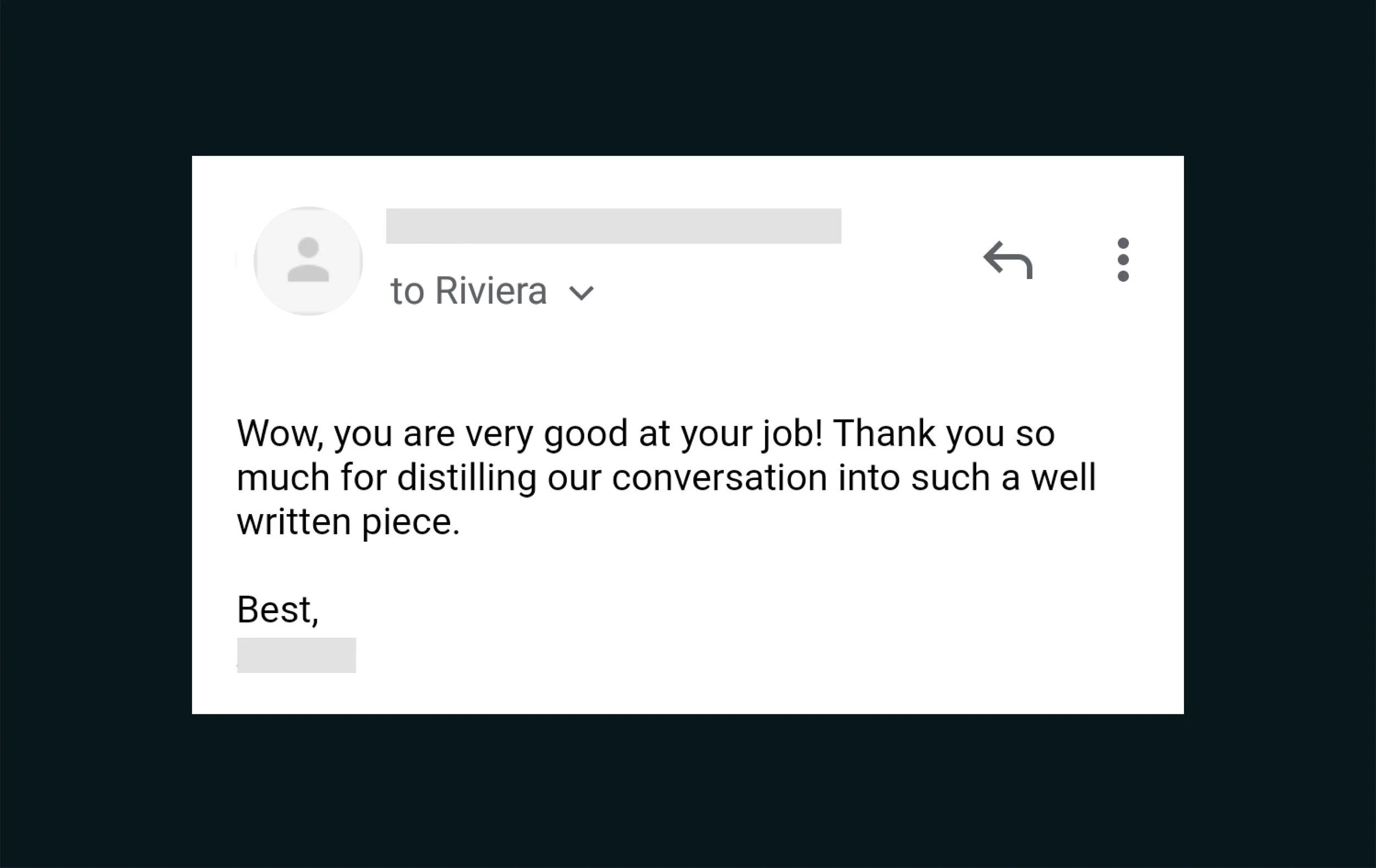
On a November evening, eager audience members gathered on a windswept bluff in San Diego. They entered an area cordoned off by red velvet ropes and were instructed to turn off their phones as they took their seats and awaited the show. The main event? They were gathered to watch a sunset. They looked on in awe as the brilliant colors unfurled over the wide-open expanse. After, the audience applauded and refreshments were served.
Remarkable things are all around us. But they rarely get noticed until someone puts a frame around them. When conducting interviews for B2B content, we sometimes need to wade through a sea of clichés and tired truisms to get to the good stuff. But if you can master the art of coaxing the best from your interviewees, then the rest is easy. All you need to do is provide the frame.
Here are four tactics you can use to extract gems from your interviewees—whether you’re writing case studies, interview-style blogs, or any other content format. Better interviewing will allow you to unearth authentic stories, quotable zingers, and pithy metaphors from your interviewees. All you’ll need to do is weave the best bits together, do some wordsmithing, and boom: You’ve got a masterpiece.
1. Don’t just ask questions, evoke emotions
Imagine I’m interviewing you about your job, and I ask: “What are the biggest pain points you experience in your role?” Maybe you have a couple you can rattle off right away. Or perhaps you feel put on the spot and have to wrestle with a bit of brain fog. Either way, chances are it won’t feel natural or easy for you to surface vivid, original stories—even though you almost certainly have some locked away somewhere in your brain.
Now, what if I asked you: “What was the most frustrating day you had on the job this year? Give me a moment when you were like, ‘I can’t take it anymore, I want to quit’?” The likelihood you’ll give me a specific, visceral story just shot up much higher.
This is because memory is state-dependent—meaning when you’re actively feeling gloomy or elated, it’s easier to recall other times when you were experiencing that same emotional state.
Since humans code memories based on emotion, tapping into these emotions is a more effective way to extract juicy information than with abstract ideas alone. You're helping interviewees more easily search their mental database for stories that match that feeling.
Specificity is also key—it helps your interviewee bust past vague ideas to access the real, thought-provoking stories within themselves. This is why questions like “Give me an example of [broad category of scenario]” can be so darn tricky to answer.
There are two elements to help your interviewees access the best material within themselves: crafting questions that touch on an emotion, and conveying that emotion in your voice. You have to make them feel it.
Here’s what it looks like in practice:

2. Schedule enough time to embrace fun
Fun is not frivolous. It’s actually crucial if you want to produce stories people will want to read. Injecting an element of play and humor in your interviews can take many forms—whether that’s spending a few minutes joking around with your interviewee, indulging the tangents that really fire them up, or starting off with a few unexpected silly questions. (“What’s your favorite quarantine snack?” always gets people to crack a smile.) If you set the tone that so-called “tangents” are okay, you’ll excavate way better material.
Often these bits of the interview end up on the cutting room floor, but sometimes these moments give me fascinating material that’s connected to the main topic in surprising ways. These details can provide the human “frame” that helps their more directly business-related insights snap into place as interesting, believable, and resonant. (And if nothing else, fun diversions build rapport—which makes interviewees open up more during the rest of the interview.)
For example, I was recently interviewing a sales executive about the data quality when he mentioned his pet theories about the distant future of sales technology. When I encouraged him to tell me more, he went deep and painted a remarkably vivid picture of a futuristic salesperson enabled with wearable technology that anticipated all of his needs, who was able to translate conversations with prospects from Japan in their native language, and report on what ideas resonated with prospects in conversations. He ended his 10-minute speech by saying, “Now I’m rambling. Pardon the tangent.” His so-called “tangent” became the perfect lede.
“His so-called “tangent” became the perfect lede.”
In the past, I used to keep interviews as short as possible, wanting to respect my interviewee’s time. But I’d often end up feeling I had to rush through the fun parts of our conversation because I couldn’t see how it was strictly relevant right away. Now I always tack on an extra 15 minutes to make space for the unexpected to emerge. The difference in quality makes it so worth it. And the interviewees often enjoy themselves so much that they don’t mind at all—they’ll even offer to run over our allotted time.
3. Want better answers? Ask more personalized questions
I was recently interviewing a CMO of a large technology company, and he paused after I asked him a question and said something that was music to my ears: “I feel like I've gotten a lot of the typical CMO questions before, but you're really making me think on these. It’s fun!”
The problem with too many B2B interviews is that they’re asking the same cliché questions, so they’re yielding the same cliché answers. If you want to go deeper and produce more interesting responses, ask more personalized questions. By doing so, I was able to crack through this CMO’s typical talking points and access material other interviewers weren’t getting.
The best way to formulate personalized questions? Research, and lots of it. It also helps if you glimpse past someone’s professional persona to research the things that make them unique as an individual. Because the personal inevitably feeds the professional, sometimes in surprising ways. In my pre-interview exploration, I found out that the CMO speaks an impressive four languages. Since our interview was focused around data integration, I fed him the seed of an analogy that getting different data providers to talk was almost like translating between different languages, and asked him if it rang true in his experience. He immediately responded that it did, and extended the metaphor in interesting ways I hadn’t even thought of.
Ultimately, personalized questions allow you to take a shortcut into territory your interviewee cares about. You’re building trust by making them feel seen and heard, which allows them to let their guard down. And best of all, you’re allowing new ideas to form and flow out—not just a rehash of their rehearsed talk tracks.
4. The trick to evocative analogies? Get your interviewees to do the work for you
If you’re this far into the article, you’ve probably gathered by now that I love a good metaphor. If I can find some clever parallel between a person’s passion project and their work when profiling them, I feel like I’ve struck gold.
The problem is it can be tricky to (a) uncover an interesting personal tidbit with enough detail to write about it (b) find how it parallels their work and (c) write it in a way where both seamlessly mirror one another. You also never want it to feel forced.
The good news is that I’ve discovered a way to strike gold again and again: Get your interviewee to do the work for you.
Here’s how it’s done.
Step 1: Ask an open-ended question to discover something your subject is passionate about.
A few of my go-to questions are asking about the best thing they've read lately, or their hobbies outside of work. When they answer, I listen not only for the words they say, but also to the resonance in their body language. If they get visibly excited and start talking with their hands a mile a minute about something, I know it’s a great topic to probe deeper with follow-up questions.
Certainly don’t feign interest, but if you genuinely feel fascinated by what they’re saying, make sure you embody it with your own body language—it’ll bolster their confidence enough to get the good stuff out.
Step 2: Prompt them to connect the dots.
Ask them: “Do you ever see parallels between [hobby we just talked about] and [your main area of expertise]?” I’ve been astounded by how quickly people connect the dots, and the interesting examples they come up with. Since your interviewee is an expert in both their day job and their hobby, they’ve probably spent years observing the parallels between the two, whether they’re aware of it or not.
I was interviewing a marketing operations consultant who had studied fine arts and used to work as a printmaker. Here’s an actual transcript of a call where I asked this:

She was so excited by the question that she cut me off to start listing them off without skipping a beat. Her face lit up as she described how both marketing operations and printmaking are about intricately layered processes to produce a desired result in the most efficient way possible. This made a wonderfully unique opening angle for her piece.
The icing on the interview cake—you’ve just created an eager content sharer
Experts frequently tell us that content marketing should be 20% creation and 80% promotion. But these categories aren’t mutually exclusive—the cleverest content creation often has promotion tactics baked right in. If you’ve followed the four tips above, then congratulations! You’ve already laid the groundwork for successful promotion.
If you can tap into something authentic and noteworthy about your interviewee—maybe even something they don’t even realize is a strength of theirs—they will love you for uncovering it and eagerly help promote your piece. This is powerful because people often don’t know how interesting they are. According to the Dunning-Kruger effect, the smartest people often underestimate themselves the most. The most brilliant minds among us often feel they have nothing noteworthy to say. (The least brilliant ones, well … just spend some time on Twitter.)
“The most brilliant minds among us often feel they have nothing noteworthy to say. (The least brilliant ones, well … just spend some time on Twitter.)”
When I published a piece presenting a marketing consultant as a hero on a mission to elevate her industry, she shared the piece widely, attracting lots of traffic for our client, and she even referred our agency to a new client. Interviewing well became a vehicle to build strong relationships and generate new business.
Yet another interviewee had glowing things to say after she saw her final piece:

There's so much talk about making content marketing more “human,” but so often the advice feels too vague and fluffy to be applicable. For me, an interview series is a concrete, tangible content campaign you can run to accomplish this. As an interviewer, I’m on a perpetual search for sparks of individual authenticity that are rooted in more universal human truths.
To me, being “human” means cutting through rehearsed talking points and old regurgitated wisdom to look at each interviewee as a remarkable individual unlike anyone else, and create the conditions for them to find and express their own uniqueness. Then all that’s left for you to do is provide the frame.
